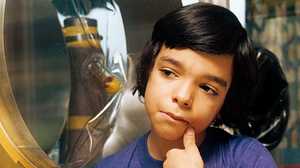David Vetter Gets a Germ-Free Mobile Suit

In 1974 doctors at Texas Children's Hospital caring for David Vetter considered how they might help him experience life beyond the stationary isolator bubbles that protected him from the germs to which he was so susceptible. They needed engineers who understood life support systems and synthetic fabrics, who could "dock" the suit with the isolator, and who allowed no margin of error. Luckily, those engineers worked down the road at NASA's Johnson Space Center.
A $50,000 Wonder
NASA had in fact built David's isolators. By 1977 engineers at NASA had created the Mobile Biological Isolation System, an enclosed spacesuit based on the isolator garments astronauts wore while quarantined after a spaceflight. A NASA brochure explained, "The suit's body is made from rubberized nonporous fabric similar to that used in life rafts. For added protection, it is covered with a white silky material, Nomex, identical to that used on the outer garments worn by astronauts during EVA [extra vehicular activity, i.e. spacewalks] on the early Gemini flights." Boots, gloves and a helmet were attached. The suit came with a life support system mounted on a lawnmower chassis that filtered air and directed it through a twelve-foot hose into the helmet (vents were located near the ankles). The entire apparatus cost $50,000.
Fear and Courage
That July David's parents and friends, NASA engineers and a camera crew all gathered in his hospital room to watch him try on the suit. To get in, he had to crawl feet first with his arms above his head through an eight-foot-long fabric tube into the suit. David was scared and kept delaying. Finally, after the camera crew had left, he ventured through the tunnel and into the suit. "I like it," he decided.
New Sensations
David's mother Carol Ann remembered, "When he first tried to walk in the suit, he lumbered about like a sailor trying to get his land legs. He had grown so accustomed to the cushiony feeling underfoot in his bubble that he found it difficult to walk on a hard surface." Psychologist and friend Mary Murphy recalled David walking down the hall of the hospital and offering ice to a nurse. It was the first time he had taken more than half a dozen steps in one direction.
Limits on Suit Use
There were limitations to the use of the suit, however. Three people who were trained to operate the suit had to be on hand at all times (only four people qualified: David's parents and two NASA engineers). The suit's power supply lasted only four hours and it only docked with his hospital isolator, so allowing an hour to get into the suit, and an hour travel each way, David had only an hour in the suit at home.
Simple Pleasures
At home, David acted like a normal five year old. He watered the lawn in the back yard of his house — and then sprayed water at everyone present. He played with the family dogs and laughed when they chased a cat. After falling to the ground, he ripped up blades of grass and tossed them in the air. Inside the house he explored his parents' and sister's rooms, and other spaces he had never seen. He enjoyed using an electric pencil sharpener so much that he broke pencils repeatedly so he could sharpen them again. David wore the suit only five more times before outgrowing it.
Museum Artifact
Although David's condition is rare, NASA offered another version of the suit to the Children's Hospital of Los Angeles for use by children whose immune systems were temporarily disabled through chemotherapy. David's suit was eventually given to the Smithsonian Institution.







